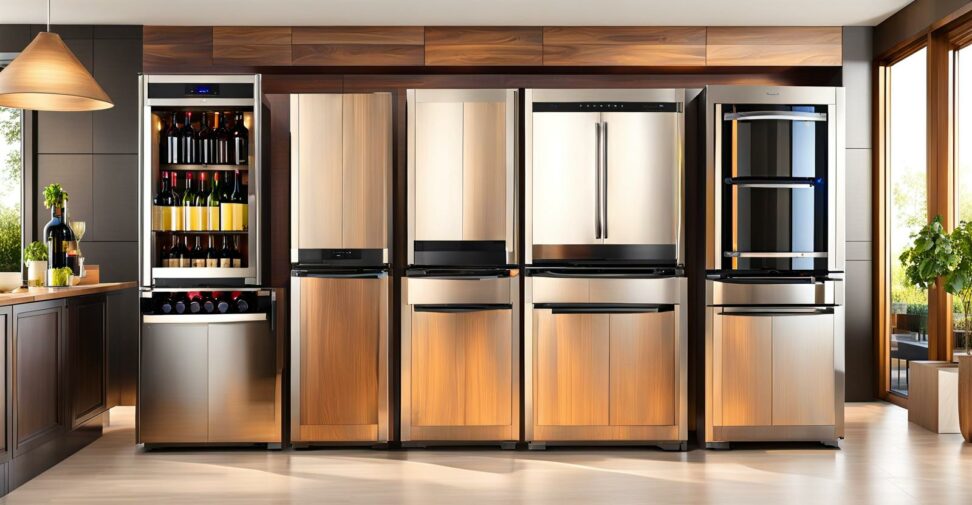Keep Your Cool With Undercounter Wine Refrigerators
With the growing popularity of home entertaining, undercounter wine refrigerators provide a convenient way to store, chill, and serve your favorite vintages right in the kitchen. Integrated seamlessly into your cabinetry, undercounter wine fridges keep your bottles instantly accessible for impromptu gatherings while maximizing your kitchen's storage capacity.
What is an Undercounter Wine Fridge?
An undercounter wine refrigerator is designed specifically to install underneath your kitchen counter or island. Unlike freestanding units, undercounter wine fridges integrate directly into your cabinetry for a unified, built-in look. Models are typically 24-34 inches wide to fit standard cabinet dimensions.
Undercounter wine coolers come in both built-in and freestanding versions. Built-in models have unfinished sides and top panels that get enclosed when installed. Freestanding units have a finished exterior for a more furniture-like look.

Benefits Over Freestanding Wine Fridges
Undercounter wine refrigerators offer several advantages over their freestanding counterparts:
- Save floorspace - Built-in under your counters rather than occupying floor area
- Hidden integrated look - Blends seamlessly into cabinetry
- Ergonomic access - Convenient at counter level instead of having to bend down
Popular Brands
Many companies produce undercounter wine coolers including U-Line, Marvel, Viking, and KitchenAid. Models range from basic refrigerators to high-end units with dual zones and extensive racking systems.
Wine Storage Temperature and Humidity
Proper temperature and humidity levels are key for both short and long-term wine storage. Undercounter wine fridges provide stable environments to keep your wines protected.
Proper Temperature for Wine
The ideal temperature for storing both reds and whites is 55°F. Red wines are typically stored between 55-60°F, while white wines are kept slightly cooler between 45-55°F.
Undercounter wine refrigerators allow you to chill wines to proper serving temperatures. Reds are best served between 60-65°F, while whites are ideal at 45-50°F.
Ideal Humidity Levels
An average humidity level of 70% helps keep corks moist and prevents drying out. Many built-in wine coolers have humidity control features or dedicated settings for maintaining optimal conditions.
Other Considerations
Look for units with vibration reduction for disturbance-free storage. UV-resistant tinted glass doors prevent lightstrike defects. Interior LED lighting illuminates your bottles for display.
Types of Cooling Systems
Undercounter wine fridges use either thermoelectric or compressor-based cooling systems. The type you need depends on your collection size and budget.
Compressor vs. Thermoelectric
For 150+ bottle collections, a compressor cooler maintains more consistent temperatures. For under 80 bottles, a thermoelectric unit usually suffices and operates more quietly.
Single and Dual Zone Cooling
Dual-zone models allow you to separate reds and whites at different temps. Single-zone functions work well for mixed collections.
Designing and Installing Your Wine Fridge
Integrating an undercounter wine refrigerator requires some cabinetry preparation and electrical considerations.
Cabinet Prep and Electrical
Ensure cabinets have proper cutout dimensions, undercabinet lighting is addressed, and adequate electrical receptacle placement.
Integrating with Your Cabinetry
For a seamless look, integrate built-in models flush with cabinet fronts. Freestanding units can stand alone or install surrounded by cabinetry.
Front-vented units need ventilation space below countertops. Rear-vented models allow for enclosed cabinet integration.
Layout and Bottle Storage
Maximize bottle capacity and cater to your collection with adjustable racking. Display favorites through glass doors.
Enjoying Your Wine With Proper Storage
Undercounter wine refrigerators keep your bottles stored properly so they're ready to enjoy anytime.
Serving Temps for Different Wines
Use your wine fridge to chill bottles to ideal serving temperatures. Reds around 60-65°F, whites around 45-50°F.
Avoiding Lightstrike and Oxidation
Store wines in darkness to prevent light damage. Use inert gas like Argon to displace oxygen and prevent oxidation.
Aging and Collecting Wine
For cellaring, 55°F with 70% humidity prevents premature aging. Track your collection with inventory software.
Undercounter wine refrigerators provide specialized storage that protects your wines and also maximizes your kitchen design. Units integrate seamlessly into cabinetry and make your bottles instantly accessible for impromptu gatherings and everyday enjoyment.